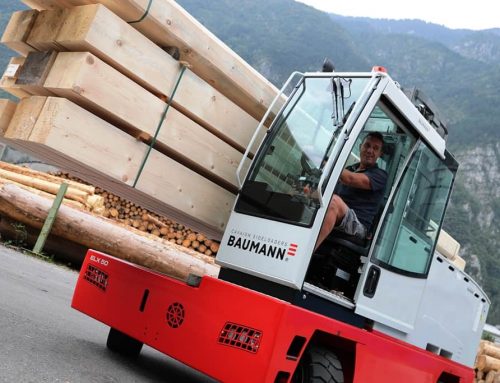There are several different types of sideloaders, which is mainly determined by these factors: power source, chassis size, capacities and mast function, deck surface, and outreach.
These specs are combined to create the perfect sideloader for the job it is needed for. Here at Baumann, we can advise you on the most suitable sideloader for your business. Just get in touch if you would like some help.
Otherwise, read on to find out all about the various types of sideloaders.
Power type

The most obvious way in which sideloaders are classified is by the way they are powered. Baumann offers diesel, electric and fuel cell powered models.
Five years ago around three-quarters of our sideloader orders were engine-powered and a quarter electric, today it’s the complete opposite.
European orders are now 80% electric. Many customers are saving money on servicing and fuel costs by switching to our electric range, as well as benefitting from the reduced noise and increased comfort.
We produce two types of electric models, the main difference being the size of the chassis. The ELX series is smaller with a lower chassis, the EGX series is higher (with larger wheels and more drive motors).
Chassis size
Sideloaders are designed to carry loads securely on their decks. The length and width of the deck is determined by the chassis size, and a number of different combinations are available to accommodate different load requirements and aisle widths.
The specification of deck widths (essentially how wide the truck is) can be varied to suit the needs of the load, but deck heights have to be set to accommodate the mechanics that lie beneath and within.
Both of our electric ranges are 120 volts, which means greater efficiency and a longer battery life.
We produced our first hydrogen fuel cell machine over a decade ago. It is fair to say that the cost of hydrogen and the improvements in our electric models, batteries and chargers, has held back the uptake of this type of power, but the recent investment in hydrogen infrastructures and it’s convenience as a fuel type, means we are still confident that there is a market for it.
Capacities & Mast Function
Baumann sideloaders also fall into three broad categories based on their load capacities.
- 3 to 6 tonnes capacity (smallest chassis)
- 6 to 10 tonnes capacity (medium chassis)
- 10 to 60 tonnes capacity (large chassis with fixed or raising cabs).

In addition to these definitions, sideloaders can also be categorised by the function of the mast and forks. Some are designed to carry loads that are wider than the truck chassis.
Sometimes when moving long loads, it’s safer to support them from their ends, not just in the middle.
Fixed spreader beams (attached to a standard carriage) are designed to sit outside the chassis of a sideloader, with an additional fork at either end. They can be extended further apart manually or hydraulically and can be folded away, again manually or hydraulically.
Hydraulic options dictate whether the spreader beam is semi-permanently fixed or can be removed easily when not in use.
Alternatively, extended carriages allow the forks to travel along the full length of the sideloader, providing a similar functionality to the spreader beam, but adding the ability to close the forks together.
It’s therefore possible to carry different lengths, such as a load with the forks positioned above the deck, or even a pallet in the sideloader well.
As a result, there aren’t two additional forks, but they can still be moved manually, hydraulically or via chains.
Deck surface
The surface of the deck is usually made of a specially reinforced composite deck board, but for handling steel it may be checker plate (also called diamond plate or steel tread plate) for protection purposes.
Hardwood timber bearers are often added to the deck for steel profile loads. Metal or wooden bearers may also be grooved to fix steel or plastic tubes in place.
Load posts can be added to protect part of the load from falling or part of the truck from damage.
Outreach
 The outreach of a sideloader is the distance the mast and forks travel towards the load from the retracted position.
The outreach of a sideloader is the distance the mast and forks travel towards the load from the retracted position.
It would be unsafe to have forks that pointed out further than the truck chassis when the mast is fully retracted, so the distance of the outreach is dictated by the deck width.
If an operation requires additional reach, either to store loads on double-deep racking, or to load a wagon from one side only, there are two additional choices – a pantograph or telescopic forks.
Add to this a host of customised options, such as turning cabins, extending decks, camera systems and lots more, whatever the long load being carried, there is a types of sideloader that can do the job!
Ready To Have A Chat?
We can help you find the right type of sideloader for you, whether you are moving pipes, cement, or timber. Get in touch with us here or email info@baumann-sideloaders.com.






